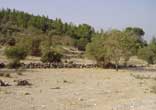In Jewish Sites
Tel Yarmot
Not far from Beit Shemesh, on the summit of a hill that overlooks the region, lies the ruins of one of the most ancient towns in the Holy Land – Yarmus. It was one of the five towns that banded together for war against Givon, long ago in the time of Yehoshua
History:
The hilltop town was first discovered in the year 5623 (1863), by French archaeologist Victor Goren. He identified the ruins as belonging to the biblical town of Yarmus, which was one of the five cities whose kings organised a war against Givon after the latter had made a peace agreement with the nation. As cited in Sefer Yehosua 10:3-4 –
“And Adoni-Zedek king of Yerushalayim sent to Hoham king of Chevron and Param king of Yarmus, and Yafia king of Lachish and Devir king of Eglon, saying: Ascend to me and assist me, and we will smite Givon, because they made peace with Yehoshua and the Jewish people.”
After the city was conquered and the Land was divided into portions, the city fell into the portion of the tribe of Yehuda. This is cited later on in Yehoshua: “This, the portion of the tribe of Yehuda, according to their families… Yarmus, Adlom, Shocha and Azaka.”
Aside from these quotes from Sefer Yehoshua regarding the city of Yarmus, a mention of the town is found also in Sefer Nechemia 11:21-29, as one of the cities to which the tribe of Yehuda returned after the Babylonian exile: “And to the courtyards, in their fields, the sons of Yehuda returned to Kiryat Arba and built it… and [to] Ein Ramon and Tzirah, and Yarmus.”
Much later, in the Byzantine era, the town of Yarmus was restored once again and given the name: ‘Yarmes’.
Excavations and Discoveries:
The excavations in Tel Yarmot began in the year 5730 (1970) by Professor Amnon ben Tur, and since then the area has been subjected to almost twenty separate archaeological expeditions.
In the course of the excavations, fascinating remains from the Biblical city of Yarmus were exposed – sections of the fortified wall surrounding the town, and a moat; remains of a large castle stretching over 6000 meters; residential areas and community buildings. From later periods there are vestiges of a smaller town built on top of the remains of the older one. During this period the town was ten times smaller than the original city, extending over 15 dunam, and rising to a height of 405 meters above sea-level. Because of its high vantage point, the town offers a picturesque view of the entire region. From within the village itself there are other magnificent viewpoints, overlooking the Yarmot and Aleh Rivers.
Being that the area is still being excavated at present; the town has not yet become an official tourist site.
 |
| Tel Yarmot [] |
 |
| [] |
 |
| [] |
 |
| [] |
 |
| [] |
 |
|
Bridge in Be'er Tikva [] |
 |
| Vineyards in "Netiv Hala" [] |
 |
| Return to the Ramat Beit Shemesh Rd. [] |







